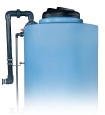As 2023 draws to a close, we reflect on the wealth of knowledge shared in our chemical storage tank blogs throughout the year. From safety protocols to innovative storage solutions, our aim has been to empower industry professionals with comprehensive insights.
Topics:
Chemicals
Chemicals stored in polyethylene tanks require venting. Depending on the chemical you’re storing, the harmful fumes emitted from the storage tank can’t be directly released into the atmosphere. To reduce the harmful fumes before they evacuate the system and to control air pollution, fume scrubbers need to be installed.
Topics:
Fittings and Accessories
Winter is approaching fast. With below freezing temperatures and snowstorms affecting millions of people each year, municipalities need to be ready to clear roadways and maintain equipment. De-icing fluid is used to break down ice and frost on roadway surfaces and aircraft. The substance used for de-icing depends on its application, the amount of snowfall, the municipality’s preferences, and winter temperatures. A variety of chemicals are used in the de-icing process, including brine, magnesium chloride, propylene glycol, and ethylene glycol. Brine is the most popular of these chemicals, but it can damage vehicles or rebar on roadways.
Topics:
Applications,
Chemical Storage
Poly Processing works diligently to produce each and every chemical storage tank to spec. But if a tank isn’t installed correctly it could lead to chemical corrosion, causing damage, leaks, safety issues for personnel, and a shorter tank life. Everyone should take chemical tank installation seriously.
Topics:
Chemicals
Secondary containment systems — a tank within a tank — are recommended safeguards that can prevent costly damage to equipment and risk to employees in the event of a leak or failure of the primary storage vessel.
Topics:
Chemicals
Receiving a Poly Processing tank, whether it's for industrial, commercial, or municipal use, is a crucial process that requires careful attention to detail. Before the tank is put into service, several essential steps must be followed to ensure its safety, functionality, and readiness.
Topics:
Applications
In addition to physical and biological treatment, wastewater treatment requires aggressive usage of large amounts of chemicals, so safe storage of them is always an important consideration.
Nitric acid, commonly known as HNO3, plays a crucial role in various industries, particularly in the chemical sector. Its applications range from manufacturing fertilizers and explosives to producing dyes and pharmaceuticals.
Topics:
Chemicals
Purchasing a chemical storage tank is a significant investment. You want confidence and reassurance that the tank will give you the dependability and longevity that was advertised. A strong and transparent warranty shows that the manufacturer believes in and stands behind their product.
Leachate and condensate from landfills typically contain hazardous materials — either from the waste itself or as a result of chemical compounds breaking down. Landfill leachate is liquid that comes in contact with or is released from waste. Condensate is the liquid generated as a result of the gas collection and recovery process. In both cases, the liquid can be extremely hazardous and can create environmental disasters that take decades to recover from.
Topics:
Chemicals



